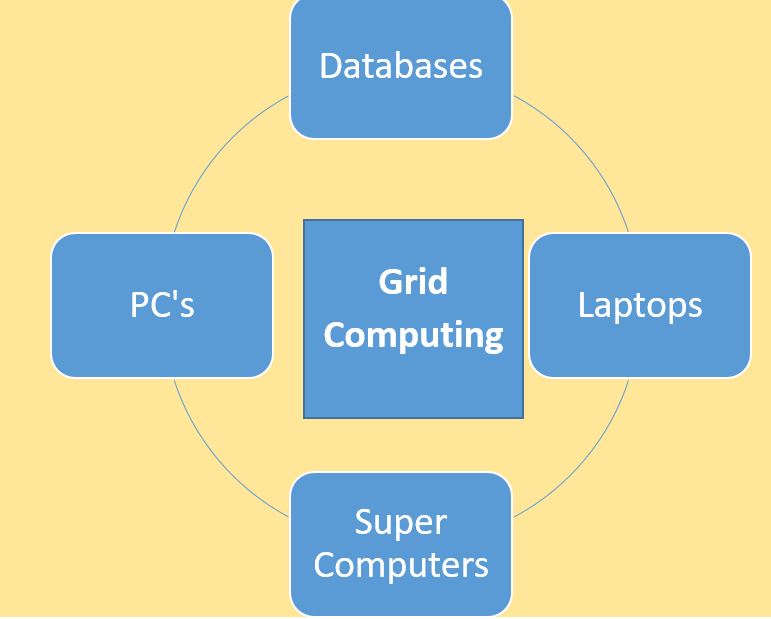Cloud Computing - Technologies
Cloud Technologies refer to a broad set of computing resources and services that are delivered over the internet, enabling users to access and utilize scalable and flexible IT resources without the need to own or manage physical hardware. There are certain technologies working behind the cloud computing platforms making cloud computing flexible, reliable, and usable.
These technologies are listed below:
- Virtualization
- Service-Oriented Architecture (SOA)
- Grid Computing
- Utility Computing
1. Virtualization
Virtualization is a technique, which allows to share single physical instance of an application or resource among multiple organizations or tenants (customers). The practice of establishing a virtual environment to run several operating systems and applications on the same server is known as virtualization. The virtual environment can be any combination of different operating systems, storage systems, network application servers, and other environments, including a single instance or a single combination of them.
Virtual machines are used more frequently because to the cloud computing idea of virtualization. A virtual machine is a computer program or piece of software that may execute activities like executing applications or other programs on demand for the user while simultaneously acting like a physical machine.
Types of Virtualization
- Hardware virtualization
- Server virtualization
- Storage virtualization
- Operating system virtualization
- Data Virtualization
Benefits of Virtualization
- More flexible and efficient allocation of resources.
- Enhance development productivity.
- It lowers the cost of IT infrastructure.
- Remote access and rapid scalability.
- High availability and disaster recovery.
- Pay peruse of the IT infrastructure on demand.
- Enables running multiple operating systems.
2. Service-Oriented Architecture (SOA)
Service-Oriented Architecture (SOA) allows organizations to access on-demand cloud-based computing solutions according to the change of business needs. Service-oriented architecture (SOA) is a method of software development that uses software components called services to create business applications. Each service provides a business capability, and services can also communicate with each other across platforms and languages. Developers use SOA to reuse services in different systems or combine several independent services to perform complex tasks.
Example
Multiple business processes in an organization require the user authentication functionality. Instead of rewriting the authentication code for all business processes, you can create a single authentication service and reuse it for all applications. Similarly, almost all systems across a healthcare organization, such as patient management systems and electronic health record (EHR) systems, need to register patients.

3. Grid Computing
Grid computing is a distributed computing paradigm that involves connecting and harnessing the computational power of multiple computers or resources from various locations to solve complex computational problems or perform large-scale data processing tasks. Grid computing is often used for scientific, engineering, and research applications that require substantial computing resources and data storage.
Mainly, grid computing is used in the ATMs, back-end infrastructures,and marketing research.
Applications of grid computing.
- Scientific Research - Grids are commonly used in scientific fields such as physics, biology, and climate modeling to run complex simulations and data analysis tasks.
- Drug Discovery - Grid computing aids in the discovery of new drugs and pharmaceutical compounds by performing extensive computational modeling and simulations.
- Financial Modeling - The financial industry uses grid computing to run risk assessments, portfolio optimization, and other computational tasks.
- Weather Forecasting - Weather prediction models benefit from the parallel processing capabilities of grid computing to provide more accurate forecasts.

4. Utility Computing
Utility computing is a computing model that provides computing resources and services on-demand, much like traditional utility services such as electricity or water. In this model, computing resources are treated as a utility, and users only pay for the resources they consume, typically on a pay-as-you-go or subscription basis.
Key characteristics of utility computing include:
- Scalability - Users can easily scale their computing resources up or down based on their needs. This scalability can be both vertical (increasing the capacity of a single resource, like adding more CPU power or memory) and horizontal (adding more instances or nodes to a distributed system).
- Resource Pooling - In utility computing, computing resources are often pooled together in a data center or a cloud infrastructure. Users share these pooled resources, which are allocated dynamically as needed.
- Self-Service - Users can provision and manage computing resources without the need for direct human intervention from the service provider. This self-service aspect is a fundamental characteristic of utility computing.
- Metered Usage - Users are charged based on their actual usage of computing resources. This can include factors like CPU usage, storage capacity, network bandwidth, and the duration for which resources are used. This pay-as-you-go model can help reduce costs and improve resource utilization.
- Accessibility via the Internet - Utility computing services are often accessible over the internet, allowing users to access their resources remotely from anywhere with an internet connection.
- Service-Level Agreements (SLAs) - Providers of utility computing services typically offer SLAs that specify the level of service, including uptime guarantees, security measures, and performance expectations.
Some well-known examples of utility computing providers include Amazon Web Services (AWS), Microsoft Azure, Google Cloud Platform (GCP), and IBM Cloud. These providers offer a wide range of computing resources and services that can be provisioned and managed by users as needed, making utility computing a foundational concept in modern IT infrastructure.
Next
